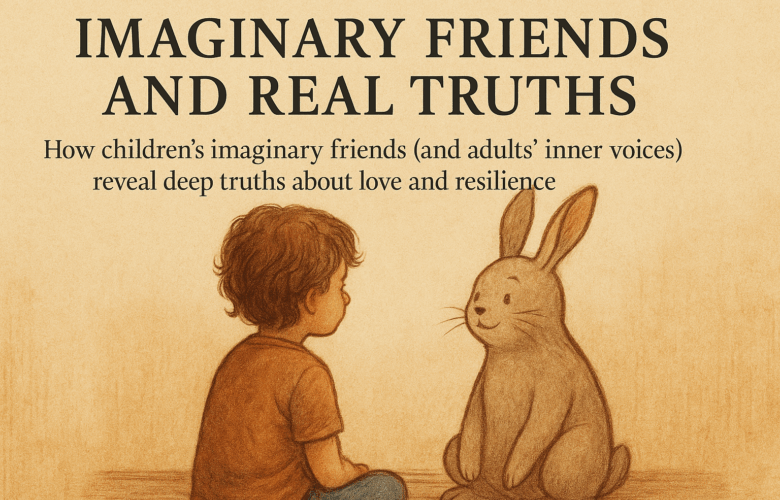Imaginary Friends and Real Truths
How children’s imaginary friends (and adults’ inner voices) reveal deep truths about love and resilience
The Companions We Create
Almost every child, at some point, invents an imaginary friend. These companions live in the liminal space between reality and dream: a teddy bear given a voice, a superhero who swoops in during lonely afternoons, or a constant playmate visible only to the one who believes. Adults often dismiss them as cute, harmless fictions, destined to be forgotten with time. But what if these companions are more than passing whimsy? What if they reveal something profound about the human spirit—the way we survive loneliness, practice love, and cultivate resilience?
Love, Practiced in Pretend
Imaginary friends are rehearsal halls for the heart. Children use them to practice kindness, loyalty, and forgiveness. In comforting their companions, they learn how to comfort themselves. In sharing their secrets, they discover that vulnerability can be safe. Through the lens of pretend, they are preparing for very real relationships.
The first seeds of love are planted in the arms of those who care for us. But it’s in the garden of our imagination that we they are watered and grow. And our imaginary interactions are where we practice kindness, forgiveness, and loyalty until these qualities become part of who we are.
The Inner Chorus of Adulthood
Children are not alone in this. Adults, too, carry inner companions. They might not wear capes or sit at the breakfast table, but they appear as inner voices: a wise mentor who counsels us in moments of doubt, a stern critic who demands better, or a cheerleader who whispers, You’ve got this.
These voices are just as invented as childhood companions, but no less real in their effects. They guide our choices, shape our confidence, and sometimes hold us back. Like children, we use them to navigate a complex world—to stay steady in storms, to imagine new possibilities, to test our courage.
Resilience Through Imagination
Resilience is not only built by enduring hardship but by finding ways to hold ourselves together while we endure it. Imaginary friends—whether childish or adult—are tools of resilience. They give us dialogue when silence feels unbearable. They remind us of play when life turns heavy. They embody hope when evidence seems scarce.
Even trauma survivors often describe the presence of an inner figure—sometimes a protector, sometimes a nurturer—who helped them endure. The imagination becomes a sanctuary, and the characters within it are guardians of survival.
Real Truths in Imagined Beings
What makes something “real”? If real means measurable, then imaginary friends are not. But if real means having power to shape our emotions, our choices, and our lives, then they are as real as anything else. The truths they reveal—that we are capable of love, that we can sustain ourselves through connection, that resilience is woven into the fabric of our creativity—are truths worth honoring.
An Invitation to Remember
Perhaps it’s time we stop dismissing these companions as childish illusions. Instead, we might remember them as guides. What did your imaginary friend teach you about kindness? About courage? About joy?
And for those who never had one, consider this: the voices you carry today—whether gentle or harsh, encouraging or doubtful—are also imagined companions. What might change if you shaped those voices with intention, letting them speak with compassion instead of condemnation?
In the end, imaginary friends remind us that love and resilience are not given to us by the world—they are created within us, nurtured by imagination, and carried into every real relationship we will ever have.


